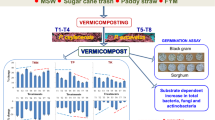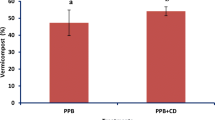Abstract
Vermicomposting is a feasible method for disposing of lignocellulosic waste while generating a useful product. The current study assessed the potential of vermicomposting green waste mixed with sugarcane bagasse in proportions of 25%, 50%, and 75% (v:v, based on dry weight). The suitability was evaluated based on the agrochemical properties, earthworm biomass, and phytotoxicity. The final vermicomposts exhibited near-neutral pH values (7.1–7.6), and lower EC values (0.43–0.72 mS/cm) and C:N ratios (14.1–19.9).The content of available nutrients and CEC for all the vermicomposts exceeded those of the control compost (without earthworms). For vermicomposts, the average values of NO3−-N, AP, AK, and CEC were 53, 517, 1362 mg/kg, and 158 cmol/kg, respectively. The total contents of heavy metals increased in all vermicompost treatments compared to control composts with the following average final percentages: Zn (2.0%), Cr (15.5%), Pb (23.4%), and Cu (44.3%), but these amounts were safe for application in agroforestry. The addition of sugarcane bagasse to green waste significantly increased the content of total humic substance, humic acid and urease activity, acid and alkaline phosphatase activity, and Eisenia fetida reproduction. The addition of 25% sugarcane bagasse to green waste decreased the toxicity to germinating seeds. These results revealed that vermicomposting is a feasible way to degrade green waste into a value-added chemical product.

Similar content being viewed by others
References
Barje F, El Fels L, El Hajjouji H, Winterton P, Hafidi M (2013). Biodegradation of organic compounds during co-composting of olive oil mill waste and municipal solid waste with added rock phosphate. Environmental Technology, 34(21): 2965–2975
Bhat S A, Singh J, Vig A P (2014). Genotoxic assessment and optimization of pressmud with the help of exotic earthworm Eisenia fetida. Environmental Science and Pollution Research International, 21(13): 8112–8123
Bhat S A, Singh J, Vig A P (2015). Potential utilization of bagasse as feed material for earthworm Eisenia fetida, and production of vermicompost. SpringerPlus, 4(1): 11
Bohacz J, Korniłłowicz-Kowalska T (2009). Changes in enzymatic activity in composts containing chicken feathers. Bioresource Technology, 100(14): 3604–3612
Brinton W F (2000). Compost Quality Standards and Guidelines. Report to New York State Association of Recyclers by Woods End Research Laboratory Inc. USA
British Standards Institution (2011). PAS 100: 2011 Specification for composted materials. (ISBN 978 0 580 65307 0)
Cai L, Gong X, Sun X, Li S, Yu X (2018). Comparison of chemical and microbiological changes during the aerobic composting and vermicomposting of green waste. PLoS One, 13(11): e0207494
Garg V K, Gupta A, Satya S (2006). Vermicomposting of different types of waste using Eisenia foetida: A comparative study. Bioresource Technology, 97(3): 391–395
Garg V K, Suthar S, Yadav A (2012). Management of food industry waste employing vermicomposting technology. Bioresource Technology, 126: 437–443
Gómez-Brandón M, Lazcano C, Domínguez J (2008). The evaluation of stability and maturity during the composting of cattle manure. Chemosphere, 70(3): 436–444
Gong X Q, Cai L L, Li S Y, Chang S X, Sun X Y, An Z F (2018a). Bamboo biochar amendment improves the growth and reproduction of Eisenia fetida and the quality of green waste vermicompost. Ecotoxicology and Environmental Safety, 156: 197–204
Gong X Q, Li S Y, Chang S X, Wu Q, Cai L L, Sun X Y (2019). Alkyl polyglycoside and earthworm (Eisenia fetida) enhance biodegradation of green waste and its use for growing vegetables. Ecotoxicology and Environmental Safety, 167: 459–466
Gong X Q, Li S Y, Sun X Y, Wang L, Cai L L, Zhang J D, Wei L (2018b). Green waste compost and vermicompost as peat substitutes in growing media for geranium (Pelargonium zonale, L.) and calendula (Calendula officinalis, L.). Scientia Horticulturae, 236: 186–191
Gopal M, Gupta A, Sunil E, Thomas G V (2009). Amplification of plant beneficial microbial communities during conversion of coconut leaf substrate to vermicompost by Eudrilus sp. Current Microbiology, 59(1): 15–20
Hanc A, Chadimova Z (2014). Nutrient recovery from apple pomace waste by vermicomposting technology. Bioresource Technology, 168: 240–244
Karak T, Kutu F R, Paul R K, Bora K, Das D K, Khare P, Das K, Dutta A K, Boruah R K (2017). Co-composting of cow dung, municipal solid waste, roadside pond sediment and tannery sludge: Role of human hair. International Journal of Environmental Science and Technology, 14(3): 577–594
Kaviraj S S, Sharma S (2003). Municipal solid waste management through vermicomposting employing exotic and local species of earthworms. Bioresource Technology, 90(2): 169–173
Kayikçioğlu H H, Okur N (2011). Evolution of enzyme activities during composting of tobacco waste. Waste Management & Research, 29(11): 1124–1133
Kazemi K, Zhang B, Lye L M, Zhu Z (2017). Evaluation of state and evolution of marine fish waste composting by enzyme activities. Canadian Journal of Civil Engineering, 44(5): 348–357
Komilis D P, Tziouvaras I S (2009). A statistical analysis to assess the maturity and stability of six composts. Waste Management (New York, N.Y.), 29(5): 1504–1513
Kumar R, Verma D, Singh B L, Kumar U (2010). Composting of sugarcane waste by-products through treatment with microorganisms and subsequent vermicomposting. Bioresource Technology, 101(17): 6707–6711
Lazcano C, Gomez-Brandon M, Dominguez J (2008). Comparison of the effectiveness of composting and vermicomposting for biological stabilization of cattle manure. Chemosphere, 72(7): 1013–1019
Le Bayon R C, Binet F (2006). Earthworms change the distribution and availability of phosphorous in organic substrates. Soil Biology & Biochemistry, 38(2): 235–246
Tsui L, Juang M A (2010). Effects of composing on sorption capacity of bagasse-based chars. Waste Management (New York, N.Y.), 30(6): 995–999
Mohee R, Boojhawon A, Sewhoo B, Rungasamy S, Somaroo G D, Mudhoo A (2015). Assessing the potential of coal ash and bagasse ash as inorganic amendments during composting of municipal solid wastes. Journal of Environmental Management, 159: 209–217
Najjari F, Ghasemi S (2018). Changes in chemical properties of sawdust and blood powder mixture during vermicomposting and the effects on the growth and chemical composition of cucumber. Scientia Horticulturae, 232: 250–255
Oviedo-Ocaña E R, Dominguez I, Komilis D, Sánchez A (2017). Cocomposting of green waste mixed with unprocessed and processed food waste: Influence on the composting process and product quality. Waste and Biomass Valorization, 10(1): 63–74
Papafilippaki A, Paranychianakis N, Nikolaidis N P (2015). Effects of soil type and municipal solid waste compost as soil amendment on Cichorium spinosum (spiny chicory) growth. Scientia Horticulturae, 195: 195–205
Pramanik P, Ghosh G K, Ghosal P K, Banik P (2007). Changes in organic—C, N, P and K and enzyme activities in vermicompost of biodegradable organic wastes under liming and microbial inoculants. Bioresource Technology, 98(13): 2485–2494
Said-Pullicino D, Kaiser K, Guggenberger G, Gigliotti G (2007). Changes in the chemical composition of water-extractable organic matter during composting: Distribution between stable and labile organic matter pools. Chemosphere, 66: 2170–2176
Sen B, Chandra T S (2007). Chemolytic and solid-state spectroscopic evaluation of organic matter transformation during vermicomposting of sugar industry wastes. Bioresource Technology, 98(8): 1680–1683
Song X, Liu M, Wu D, Qi L, Ye C, Jiao J, Hu F (2014). Heavy metal and nutrient changes during vermicomposting animal manure spiked with mushroom residues. Waste Management (New York, N.Y.), 34(11): 1977–1983
Suthar S (2010). Recycling of agro-industrial sludge through vermitechnology. Ecological Engineering, 36(8): 1028–1036
Tandon H Z (1993). Methods of Analysis of Soils, Plant, Water and Fertilizers. Fertilizer Development and Consultation Organization, New Delhi, 1–148
Weir B L, Paulson K N, Lorenz O A (1972). The effect of ammoniacal nitrogen on lettuce (Lactuca sativa) and Radish (Raphanus sativus) Plants 1. Soil Science Society of America Journal, 36(3): 462–465
Wu J Q, Zhao Y, Yu HM, Wei D, Yang T, Wei Z, Lu Q, Zhang X (2019). Effects of aeration rates on the structural changes in humic substance during co-composting of digestates and chicken manure. Science of the Total Environment, 658: 510–520
Wu J Q, Zhao Y, Zhao W, Yang T X, Zhang X, Xie X Y, Cui H Y, Wei Z M (2017). Effect of precursors combined with bacteria communities on the formation of humic substances during different materials composting. Bioresource Technology, 226: 191–199
Yadav A, Garg V K (2011). Vermicomposting–an effective tool for the management of invasive weed Parthenium hysterophorus. Bioresource Technology, 102(10): 5891–5895
Yadav A, Suthar S, Garg V K (2015). Dynamics of microbiological parameters, enzymatic activities and worm biomass production during vermicomposting of effluent treatment plant sludge of bakery industry. Environmental Science and Pollution Research International, 22(19): 14702–14709
Zhang L, Sun X (2017). Using cow dung and spent coffee grounds to enhance the two-stage co-composting of green waste. Bioresource Technology, 245: 152–161
Zhang L, Sun X Y (2016). Improving green waste composting by addition of sugarcane bagasse and exhausted grape marc. Bioresource Technology, 218: 335–343
Zucconi F, Forte M, Monac A, de Bertodi M (1981). Biological evolution of compost maturity. BioCycle, 22: 27–29
Acknowledgments
This work was funded by the National Forestry Public Welfare Project of China (Grant No. 201504205).
Author information
Authors and Affiliations
Corresponding author
Additional information
Highlights
• Earthworms were able to convert green waste into more plant-available nutrients.
• The part of heavy metals content increased in the compost added by earthworm.
• The addition of SCB to GW did enhance earthworm biomass and humic acid content.
• The resulting vermicomposts were characterized by neutral pH and lower EC value.
Electronic supplementary material
Rights and permissions
About this article
Cite this article
Cai, L., Sun, X., Hao, D. et al. Sugarcane bagasse amendment improves the quality of green waste vermicompost and the growth of Eisenia fetida. Front. Environ. Sci. Eng. 14, 61 (2020). https://doi.org/10.1007/s11783-020-1240-2
Received:
Revised:
Accepted:
Published:
DOI: https://doi.org/10.1007/s11783-020-1240-2




